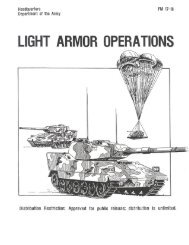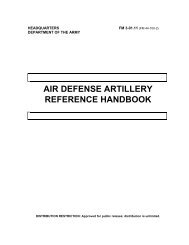fm 44-100 us army air and missile defense operations
fm 44-100 us army air and missile defense operations
fm 44-100 us army air and missile defense operations
Create successful ePaper yourself
Turn your PDF publications into a flip-book with our unique Google optimized e-Paper software.
FM <strong>44</strong>-<strong>100</strong><br />
6-<strong>100</strong>. Factors for assigning comm<strong>and</strong> or support relationships are battle<br />
comm<strong>and</strong>, unity of comm<strong>and</strong>, survivability, <strong>and</strong> s<strong>us</strong>tainability. The appropriate<br />
comm<strong>and</strong> or support relationship provides ADA comm<strong>and</strong>ers the flexibility<br />
<strong>and</strong> authority to synchronize their forces vertically <strong>and</strong> horizontally.<br />
When determining comm<strong>and</strong> or support relationships, the ADA comm<strong>and</strong>er<br />
retains a unified internal chain of comm<strong>and</strong>. When considering the factor of<br />
survivability, the ADA comm<strong>and</strong>er analyzes the degree of risk to the ADA<br />
unit vers<strong>us</strong> mission accomplishment. The final factor in determining the<br />
comm<strong>and</strong> or support relationship is s<strong>us</strong>tainability of the ADA force. The<br />
comm<strong>and</strong>er m<strong>us</strong>t ensure each unit will receive all required logistical support.<br />
Failure to consider these four factors when assigning a unit's comm<strong>and</strong> or<br />
support relationship will degrade the integrated ADA coverage of the force<br />
<strong>and</strong> threaten freedom to maneuver. The finalized ADA plan integrates task<br />
organization <strong>and</strong> comm<strong>and</strong> or support relationships with the ADA concept of<br />
<strong>operations</strong>.<br />
EXECUTION OF TACTICAL OPERATIONS<br />
6-101. Execution is the final <strong>and</strong> most critical stage of the decision-making<br />
process. Beca<strong>us</strong>e of the importance of this stage, comm<strong>and</strong>ers <strong>and</strong> staffs m<strong>us</strong>t<br />
actively supervise the synchronized execution of the plan. During the operation,<br />
friendly ADA m<strong>us</strong>t have the flexibility to respond to changes in METT-<br />
TC. The ability to perform the battlefield tasks provides flexibility to execute<br />
the plan <strong>and</strong> to continuo<strong>us</strong>ly provide ADA coverage to the force.<br />
Shoot<br />
6-102. All combatants on the battlefield go through the same steps to deliver<br />
fire on a target. Combatants m<strong>us</strong>t detect, acquire, classify, identify, select,<br />
<strong>and</strong> engage targets to destroy them. A disc<strong>us</strong>sion of each step follows:<br />
• Detect. ADA systems m<strong>us</strong>t discern the presence of an enemy <strong>air</strong><br />
element that is or may become a threat, or the presence of facilities<br />
critical to the support of that enemy <strong>air</strong> element. Early detection<br />
dem<strong>and</strong>s continuo<strong>us</strong> surveillance of the battlefield.<br />
• Acquire. ADA systems m<strong>us</strong>t obtain data defining the position of<br />
the enemy <strong>air</strong> element. The data m<strong>us</strong>t be sufficiently accurate to<br />
provide targeting information.<br />
• Classify. ADA systems m<strong>us</strong>t declare a target an <strong>air</strong> breathing<br />
object (ABO) or a ballistic <strong>missile</strong> (BM). Capabilities dictate that<br />
ADA units engage threatening ballistic <strong>missile</strong>s based on classification,<br />
not identification.<br />
• Identify. ADA systems m<strong>us</strong>t determine if a potential <strong>air</strong>breathing<br />
target is friendly or enemy. Ideally, the identification<br />
process would discriminate between real targets <strong>and</strong> decoys, <strong>and</strong><br />
even identify the type of enemy target.<br />
• Select Target. ADA systems m<strong>us</strong>t analyze each target to determine<br />
if <strong>and</strong> when it should be destroyed or engaged IAW the<br />
threat posed, the tactical benefit, <strong>and</strong> the comm<strong>and</strong>er’s guidance.<br />
ADA systems m<strong>us</strong>t prioritize threat targets for engagement <strong>and</strong><br />
destruction.<br />
6-23











